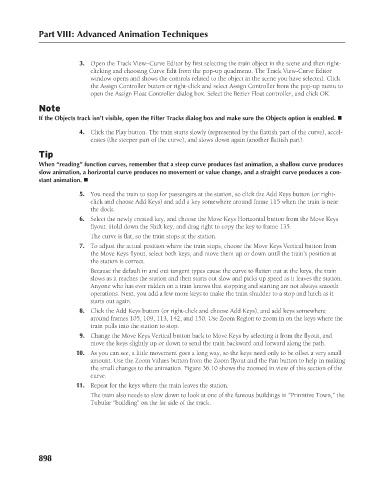Page 946 - Kitab3DsMax
P. 946
Part VIII: Advanced Animation Techniques
3. Open the Track View–Curve Editor by first selecting the train object in the scene and then right-
clicking and choosing Curve Edit from the pop-up quadmenu. The Track View-Curve Editor
window opens and shows the controls related to the object in the scene you have selected. Click
the Assign Controller button or right-click and select Assign Controller from the pop-up menu to
open the Assign Float Controller dialog box. Select the Bézier Float controller, and click OK.
Note
If the Objects track isn’t visible, open the Filter Tracks dialog box and make sure the Objects option is enabled. n
4. Click the Play button. The train starts slowly (represented by the flattish part of the curve), accel-
erates (the steeper part of the curve), and slows down again (another flattish part).
Tip
When “reading” function curves, remember that a steep curve produces fast animation, a shallow curve produces
slow animation, a horizontal curve produces no movement or value change, and a straight curve produces a con-
stant animation. n
5. You need the train to stop for passengers at the station, so click the Add Keys button (or right-
click and choose Add Keys) and add a key somewhere around frame 115 when the train is near
the dock.
6. Select the newly created key, and choose the Move Keys Horizontal button from the Move Keys
flyout. Hold down the Shift key, and drag right to copy the key to frame 135.
The curve is flat, so the train stops at the station.
7. To adjust the actual position where the train stops, choose the Move Keys Vertical button from
the Move Keys flyout, select both keys, and move them up or down until the train’s position at
the station is correct.
Because the default in and out tangent types cause the curve to flatten out at the keys, the train
slows as it reaches the station and then starts out slow and picks up speed as it leaves the station.
Anyone who has ever ridden on a train knows that stopping and starting are not always smooth
operations. Next, you add a few more keys to make the train shudder to a stop and lurch as it
starts out again.
8. Click the Add Keys button (or right-click and choose Add Keys), and add keys somewhere
around frames 105, 109, 113, 142, and 150. Use Zoom Region to zoom in on the keys where the
train pulls into the station to stop.
9. Change the Move Keys Vertical button back to Move Keys by selecting it from the flyout, and
move the keys slightly up or down to send the train backward and forward along the path.
10. As you can see, a little movement goes a long way, so the keys need only to be offset a very small
amount. Use the Zoom Values button from the Zoom flyout and the Pan button to help in making
the small changes to the animation. Figure 36.10 shows the zoomed in view of this section of the
curve.
11. Repeat for the keys where the train leaves the station.
The train also needs to slow down to look at one of the famous buildings in “Primitive Town,” the
Tubular “building” on the far side of the track.
898

